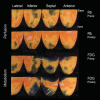Myoangiogenesis after cell patch cardiomyoplasty and omentopexy in a patient with ischemic cardiomyopathy
- PMID: 16429914
- PMCID: PMC1351841
Myoangiogenesis after cell patch cardiomyoplasty and omentopexy in a patient with ischemic cardiomyopathy
Abstract
We describe a procedure to promote angiogenesis and impregnation of skeletal myoblast into infarcted myocardium. At the completion of coronary artery bypass surgery, the midline sternotomy incision was extended to open the abdomen, and the greater omentum was tailored to reach the myocardium. Four pieces of autologous rectus muscle were applied to the infarcted left ventricle. This implantation was reinforced by the greater omentum. Incisions were closed in the usual manner. Postoperatively, the patient showed significant improvements in left ventricular ejection fraction (from 0.15 to 0.40) and in exercise tolerance (from 3 METs to 6 METs, or 100%). Computed tomographic angiography and positron emission tomography demonstrated improved myocardial viability and vascularity in the ischemic segments of the left ventricle. Omentopexy and cell patch cardiomyoplasty in conjunction with coronary artery bypass surgery may stimulate myogenesis and angiogenesis in avascular, dyskinetic scar tissue of left ventricle; in this preliminary study, this procedure appeared to improve the functional capacity of the left ventricle.
Figures





References
-
- Loebe M, Soltero E, Thohan V, Lafuente JA, Noon GP. New surgical therapies for heart failure. Curr Opin Cardiol 2003;18:194–8. - PubMed
-
- McCarthy PM. Synergistic approaches in the surgical treatment of heart failure: complex solutions for complex problems. Semin Thorac Cardiovasc Surg 2002;14:187–9. - PubMed
-
- O'Connor CM, Velazquez EJ, Gardner LH, Smith PK, Newman MF, Landolfo KP, et al. Comparison of coronary artery bypass grafting versus medical therapy on long-term outcome in patients with ischemic cardiomyopathy (a 25-year experience from the Duke Cardiovascular Disease Databank). Am J Cardiol 2002;90:101–7. - PubMed
-
- Hausmann H, Topp H, Siniawski H, Holz S, Hetzer R. Decision-making in end-stage coronary artery disease: revascularization or heart transplantation? Ann Thorac Surg 1997; 64:1296–302. - PubMed
-
- Menasche P, Hagege AA, Vilquin JT, Desnos M, Abergel E, Pouzet B, et al. Autologous skeletal myoblast transplantation for severe postinfarction left ventricular dysfunction. J Am Coll Cardiol 2003;41:1078–83. - PubMed
Publication types
MeSH terms
LinkOut - more resources
Full Text Sources
Medical
